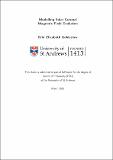Files in this item
Modelling solar coronal magnetic field evolution
Item metadata
| dc.contributor.advisor | Hood, Alan W. | |
| dc.contributor.author | Goldstraw, Erin Elizabeth | |
| dc.coverage.spatial | xx, 222 p. | en_US |
| dc.date.accessioned | 2020-01-07T10:11:47Z | |
| dc.date.available | 2020-01-07T10:11:47Z | |
| dc.date.issued | 2019-12-03 | |
| dc.identifier.uri | https://hdl.handle.net/10023/19238 | |
| dc.description.abstract | Footpoint motions at the photosphere can inject energy into the magnetic field in the solar corona. This energy is then released in the corona as heat. There are many mathematical approaches to model the evolution of these magnetic fields. Magnetohydrodynamics (MHD) provides the most convenient and practical approach. However, there are many alternative approximate methods. It is difficult to know when an approximate method is valid and how well the assumptions need to be satisfied for the solutions to be accurate enough. To illustrate this, a simple experiment is performed. Four approximate methods, including Reduced MHD (RMHD), are used to model the evolution of a footpoint driven coronal loop through sequences of equilibria. The predicted evolution from each method is compared to the solution from full MHD simulations to test the accuracy of each method when the relevant assumptions are adjusted. After this initial test, the validity of RMHD is investigated for the particular case of the magnetic field evolution involving the development of the tearing instability. Full MHD simulations are used to argue the applicability of the assumptions and conditions of RMHD for this evolution. The potential of this setup to heat the corona is considered by performing full MHD simulations including thermodynamic processes of optically thin radiation and thermal conduction. These additional processes are not included in RMHD. | en_US |
| dc.language.iso | en | en_US |
| dc.publisher | University of St Andrews | |
| dc.subject.lcc | QB539.M23G7 | |
| dc.subject.lcsh | Sun--Corona--Magnetic fields--Mathematical models | en |
| dc.subject.lcsh | Magnetohydrodynamics | en |
| dc.title | Modelling solar coronal magnetic field evolution | en_US |
| dc.type | Thesis | en_US |
| dc.type.qualificationlevel | Doctoral | en_US |
| dc.type.qualificationname | PhD Doctor of Philosophy | en_US |
| dc.publisher.institution | The University of St Andrews | en_US |
| dc.identifier.doi | https://doi.org/10.17630/10023-19238 |
This item appears in the following Collection(s)
Items in the St Andrews Research Repository are protected by copyright, with all rights reserved, unless otherwise indicated.

